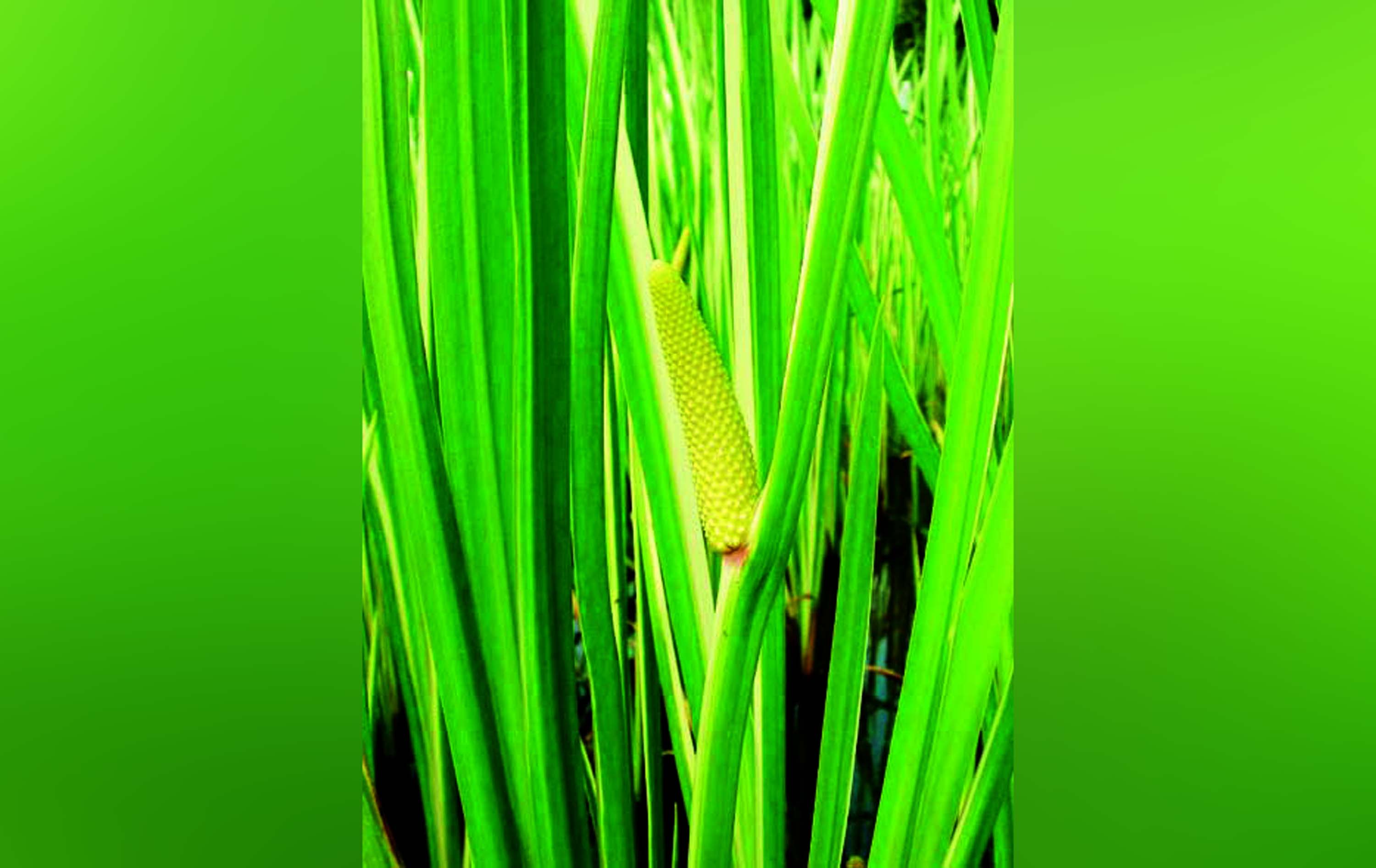Dr Vikas Sharma and Insha Rasool
Acorus calamus , commonly known as “sweet flag” or “calamus”, and belonging to family Acoraceae, is a wetland, semi aquatic, perennial, aromatic herb with creeping rhizomes. The plant is a native of Central Asia, North America and Europe. It is found in marshes (wild or cultivated) and ascending the Himalayas up to 2200 m. It is plentiful in marshy tracts of Kashmir and Sirmaur (Himachal Pradesh), in Manipur and Naga Hills. It is also regularly cultivated in the Koratagere Taluka of Karnataka State in peninsular India. The plant is called Buch, Ghorbach or Safed bach in Hindi; Vacha in Sanskrit; Vachi, Vaigandar in Kashmir; Vacha in Ayurvedic; Vaj in turki or Bacch in Unani.
Traditional use: Many ethnomedicinal and ethnobotanical uses have been ascribed to the rhizomes of the plant. Sweet flag is commonly known drug in traditional system of medicine. The scented leaves and rhizomes of sweet flag have been traditionally used as a medicine and the dried and powdered rhizome has a spicy flavour and is used as a substitute for ginger, cinnamon and nutmeg for its odour. A. calamus has been used as traditional Chinese and Indian prescriptions for its beneficial effects on memory disorder, learning performance, lipid peroxide content and anti-aging and anticholinergic activity. Calamus is a herb used for the appetite and as an aid to the digestion. It is used for fevers, stomach cramps and cholic. The rhizomes were used for toothache and powdered rhizome for congestion. The rhizome part is also used to treat several diseases like asthma and bronchitis. Native tribes treated cough by making a decoction of the plant as a carminative and also for cholic. It is a main medhya drug, which has the property of improving the memory power and intellect. Acorus calamus is used in the conditions of vata and kapha, dysmenorrheal, nephropathy, calculi and strangury.The rhizomes of Acorus calamus contain aromatic oil that has been used medicinally since ancient times and has been harvested commercially. The extracts were used in the traditional Chinese prescription and its beneficial effects on memory disorders, on learning performance, lipid peroxidase content and anti- aging effect in senescence have been reported. In Ayurvedic medicine, Calamus is an important herb and is valued as a “rejuvenator” for the brain and nervous system and as a remedy for digestive disorders.
Pharmacology: The rhizomes are considered to possess a wide range of pharmacological activities such as antispasmodic, carminative and also used for treatment of epilepsy, mental ailments, chronic diarrhoea, dysentery, bronchial catarrh, intermittent fever and tumours. It also has the insecticidal, antifungal, antibacterial. tranquilizing, anti-diarrhoeal, anti-dyslipidaemia, neuro-protective, antioxidant, anticholinesterase, spasmolytic, vascular modulator activities. The various extracts of Acorus calamus are used for the antidiabetic, anti proliferative, immunosuppressive, hypolipidemic, mitogenic and anti-carcinogenic activity towards human lymphocytes. The different extract forms possess the antispasmodic, anthelminthic, antifungal, antibacterial, fish toxin, insecticidal, anti-diabetes, anti-proliferative, immunosuppressant, antidiarrheal, antioxidant and hypolipidemic activities. The rhizomes and leaf part were found to possess the mitogenic and anticarcinogenic activity towards human lymphocytes. Acorus calamus is also combined with Polygala root to help maintain mental and intellectual health of the elderly. When powdered, it can be of avail for depressed psychosis and dementia.
Acorus calamus has been found to be a famous remedy for the respiratory disorders due to the unique combination of airways relaxant constituents that were found in the crude extract. Three drugs i.e., Brahmi (Water hyssop), Vacha (Buch plant) and Shankhapuspi (Morning glory) used in combination as ratio 10:3.8:0.2 exhibits a significant anti-anxiety activity. Both the poly herbal formulations having A. calamus as an ingredient namely, Prasham (100 mg) and P-tabs significantly provides a good relief against insomnia, stress excitement and irritability. Vachadi gana, which consists of six plants including A. Calamus was found to be effective in case of Rheumatoid arthritis with pain, swelling and functional disability. A. calamus being a constituent in polyherbal drug namely Haritaki vati (HT), which reduced the anginal frequency and decreases the serum cholesterol and serum triglyceride levels. The alcoholic extract of A. calamus exhibited potent antiviral activity against herpes virus. A. Calamus in dose of 1.5-3 gm/day was found effective against ischaemic heart disease, improvement in chest pain, instable angina, dyspnoea reduction of body weight, improving in ECG, decreasing serum cholesterol.
Buch plant was included in many of the early herbals and has a rich history in the Chinese and Indian cultures and very few plants have gained such wide spread use in diverse cultures. This plant has been found to be a popular remedy among many cultures including Unani, Ayurvedic and Chinese practitioners for treatment of various ailments. There are still a large number of unaccomplished investigations, particularly clinical trials of sweet flag and its bioactive compounds.
(The authors are from Division of Biochemistry, FBSc., SKUAST-J)
Trending Now
E-Paper


